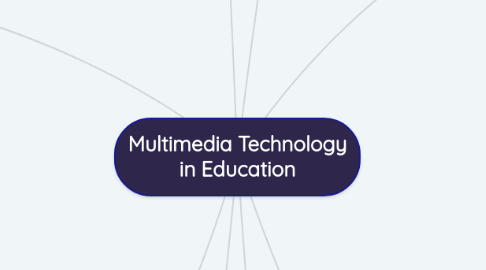
1. Elements
1.1. Static
1.1.1. Text
1.1.1.1. Words
1.1.1.2. Senteces
1.1.1.3. Paragraphs
1.1.2. Graphic
1.1.2.1. Bitmaps (Paint Graphic)
1.1.2.1.1. Real images
1.1.2.2. Vector (Draw Graphic)
1.1.2.2.1. Drawn on the computer
1.1.2.2.2. Used small memory
1.1.2.3. Drawing
1.1.2.4. Chart
1.1.2.5. Photograph
1.2. Dynamic
1.2.1. Video
1.2.2. Audio
1.2.2.1. Analog (original sound signal)
1.2.2.2. Digital (digital sampling of the actual sound)
1.2.2.3. Music
1.2.2.4. Speech
1.2.3. Animation
1.2.3.1. Still images that create an illusion of motion
1.2.3.2. Digital animation
1.3. Source: inSlideShare, Kadir, A., (Mutimedia Element, 2008)
2. Software
2.1. Desktop Publishing Software
2.1.1. Word Processor
2.1.2. Page Layout Software
2.2. Multimedia Authoring Software
2.2.1. Allow users to combine multimedia elements in an interactive application
2.3. Web Page Authoring Software
2.3.1. Help teachers in developing their own instructional software
2.3.2. Create Web pages that include all multimedia elements
2.4. Paint/Image Editing Software
2.5. Video & Audio Editing Software
2.6. Graphic Software
2.7. Animation Software
2.8. Drill & Practice Software
2.8.1. Strengthen the existing skill of the students
2.9. Reference Software
2.9.1. Encyclopedia
2.9.2. Dictionaries
2.10. Tutorial Software
2.10.1. Students learn in their own pace based on teacher instructions
2.11. Educational Software
2.11.1. Education and gaming combined into one
2.12. Simulations
2.12.1. Virtual experience
2.13. Special Need Software
2.13.1. Learning platform for special needs students
2.14. Math Problem Solving Software
2.14.1. Problem solving skills in Mathematics subject
2.14.2. Conduct Science experiment
2.15. Utility Software
2.15.1. Assist teachers in preparing test, quizzes, grading books
2.16. Source: (11 Types of Educational Software)
2.17. Source: Graphics and Multimedia Software
3. Advantages
3.1. User-friendly
3.1.1. Less energy for the user, they can sit and watch the presentation and read the text and hear the audio
3.2. Multi-sensorial
3.2.1. Uses a lot of the user's senses. E.g.: hearing, seeing & talking
3.3. Integrated & interactive
3.3.1. Different mediums are integrated through the digitization process
3.3.2. Interactivity is heightened by the possibility of easy feedback
3.4. Flexible
3.4.1. Being digital, this media can easily be changed to fit different situations and audiences
3.5. Wide variety of audiences
3.5.1. It can be used for a wide variety of audiences, ranging from one person to a whole group
4. Challenges
4.1. Lack of professional development among teachers to integrate new technologies in their classroom
4.2. Resistance to change as teachers often see technological experiment outside the scope of their job
4.3. Compete with another platform of learning like MOOCs
4.4. Delivering informal learning
4.5. Failures of personalized learning
4.6. Failure to use technology to deliver effective formative assessments
4.7. Source: The Journal (Transforming Education Through Technology)
5. What is Multimedia?
5.1. Multimedia is the combination of visual and audio representations which including elements of texts, graphic arts, sound, animation and video.
5.2. Source: National Center of Biotechnology Information
6. Hardware
6.1. Data Capture Devices
6.1.1. Video Cameras
6.1.2. Digital Cameras
6.1.3. Scanners
6.1.4. Microphones
6.1.5. Midi Hardware (Musical Instrument Digital Interface)
6.2. Data Storage Devices
6.2.1. Optical Disks
6.2.1.1. CDs
6.2.1.2. DVDs
6.2.2. External Drives
6.2.2.1. External Hard Discs
6.2.2.2. Pen Drives
6.2.3. Network Storage
6.2.3.1. Network-attached storage (NAS)
6.2.3.1.1. File management
6.2.3.1.2. E-mail
6.2.4. Cloud Computing
6.2.4.1. Public Cloud
6.2.4.2. Private Cloud
6.2.4.3. Hybrid Cloud
6.3. Data Display Devices
6.3.1. Projection Systems
6.3.2. Document Cameras
6.3.3. Monitors
6.3.4. Speakers
6.4. Source: A Multimedia Hardware Tour
7. Disadvantages
7.1. Information overload
7.1.1. Because it's so easy to use, it can contain too much information at once
7.2. Takes time to compile
7.2.1. It takes time to put the original draft together, even though it is flexible
7.3. Expensive
7.3.1. Because multimedia makes use of a wide range of resources, it can cost a large amount of money
7.4. Too much makes it unpractical
7.4.1. Adding too much of folders and files can mean that u have to use a larger computer to store the files
7.4.2. Large files like video and audio has an effect of the time it takes for your presentation to load

